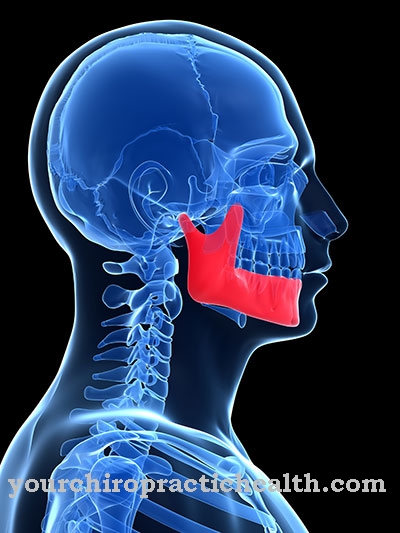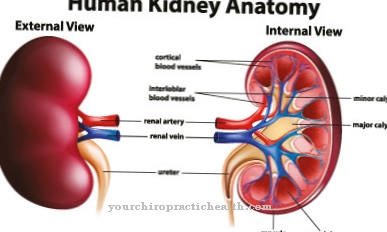A Panarteritis nodosa or Polyarteritis nodosa is a rheumatic disease that causes blood vessel inflammation. The disease is life-threatening without treatment, but treatment can usually free the patient from symptoms.
What is Panarteritis Nodosa?

© pikovit - stock.adobe.com
Panarteritis nodosa, also classic Polyarteritis nodosa called, belongs to the rheumatic diseases of the group vasculitides.
These rheumatic diseases are characterized by inflammation of the blood vessels. In panarteritis nodosa, the medium-sized arteries are mostly affected. The arteries of the gastrointestinal tract, the nervous system, the musculoskeletal system and the kidneys are particularly affected.
All layers of the wall of the affected arteries can become necrotic and inflammatory, and nodular changes occasionally occur. There is a risk of vascular bulges, so-called aneurysms, which can lead to the formation of thrombi.
Furthermore, with panarteritis nodosa, the destruction of the vessels leads to a poorer blood supply in the affected areas of the body. As a result, panarteritis nodosa can lead to the death of the tissue supplied by the affected arteries.
causes
The causes of the disease Panarteritis nodosa have not yet been fully clarified.
However, it is believed to be an autoimmune disease that breaks out due to previous infectious diseases. An autoimmune disease is to be understood as a disease in which the immune system is directed against the body's own structures and attacks them.
Some of the sick suffered from an infection with hepatitis B before the disease. It has been shown that these affected persons can have antibodies deposited on the vessel walls. These deposits trigger immune reactions there, which lead to the aforementioned inflammatory processes and their consequences.
In addition to hepatitis B, pathogens such as Coxsackie, Epstein-Barr, cytomegaly and human herpes viruses are suspected of being able to trigger panarteritis nodosa.
Symptoms, ailments & signs
Panarteritis nodosa shows itself in almost all those affected with very unspecific symptoms. For example, fever, weight loss, night sweats and muscle and joint pain occur in around 95 percent of those affected. The symptoms are reminiscent of the flu.
Four out of five people end up with neuropathy because of this form of vasculitis. This can be expressed, among other things, in visual disturbances and seizures. There is also an insufficient supply of blood to the nerves. Many of those affected also involve the digestive system, which can lead to severe and intermittent pain.
There is nausea and vomiting. In severe cases, infarctions in the liver, pancreas or spleen can also occur. An infarction of individual sections of the intestine can also occur. Men can experience testicular pain due to poor blood flow.
Angina pectoris is common in both sexes. Panarteritis nodosa also has a negative effect on the patient's mobility. Movement of the joints quickly leads to pain. Skin changes can also occur. Above all, more or less bizarre skin drawings occur that can be attributed to a slow blood flow. The risk of a heart attack is increased.
Diagnosis & course
The symptoms of a Panarteritis nodosa Disease can be quite diverse. This can lead to a high fever, loss of appetite, weight loss, weakness and night sweats.
Further symptoms depend on the area in which panarteritis nodosa occurs:
Severe abdominal pain suggests disease of an artery in the gastrointestinal tract. If the musculoskeletal system is involved, muscle and joint pain can be expected.
In the area of the heart, there is a radiating pain in the chest, pressure behind the breastbone or a feeling of heartburn. If panarteritis nodosa in the area of the heart closes the blood vessel, there is a risk of a heart attack.
In the brain, panarteritis nodosa can cause headaches, dizziness, vomiting, paralysis, speech disorders, or even a stroke.
If an artery in the kidneys is affected, the first thing that happens is increased blood pressure. Renal insufficiency threatens later.
Due to the wide variety of symptoms, making a diagnosis is not easy. An X-ray representation of the blood vessels is helpful here, as the changes are visible here. Vascular constrictions can be determined by ultrasound examinations and foci of disease in the body can be shown with imaging methods such as MRI, X-ray or CT. The suspicion of panarteritis nodosa can ultimately be confirmed by taking and examining tissue samples from the affected areas.
Complications
As a rule, panarteritis nodosa does not heal itself. Since this disease is a life-threatening disease, treatment by a doctor is definitely necessary. If panarteritis nodosa is not treated, in most cases the affected person will die.
Patients with this disease suffer primarily from severe weight loss. High fever and fatigue can also occur and thus significantly reduce the patient's quality of life. There are also stomach and intestinal problems, so that those affected also suffer from nausea and vomiting. The joints can also be painful and swollen, resulting in restricted mobility and thus in everyday life for the patient.
At night, those affected often suffer from sleep problems and night sweats. This can also lead to depression and irritability in the patient. Without treatment, panarteritis nodosa leads to renal insufficiency and thus to death of the patient. The disease can be treated with the help of medication. There are no complications. With correct and early treatment, there is also no reduction in the life expectancy of the patient.
When should you go to the doctor?
If the flu-like symptoms persist, a visit to a doctor is advisable. If the person concerned suffers from a fever, a general feeling of illness, an internal weakness or an unwanted loss of weight, the symptoms should be clarified. See a doctor about night sweats, pain, or problems in the joints. Symptoms of the muscular system, limitations of the musculoskeletal system and disorders of the digestive tract indicate a disease that needs to be treated. The person concerned needs medical care in the event of functional disorders or a seizure disorder.
Without treatment, a life-threatening condition can develop. In acute cases, the emergency services must be alerted. Patients report intermittent pain as characteristic of panarteritis nodosa. You should refrain from taking pain medication until you have consulted the attending physician in order to avert risks. Nausea and vomiting as well as skin irregularities should also be presented to a doctor.
If men suffer from testicular pain and sexual dysfunction, an extensive examination is recommended. Disorders of the blood flow or the cardiovascular system are considered to be worrying and must be examined by a doctor as soon as possible to avoid complications. If there are impairments in coping with everyday life or if participation in usual leisure activities and sporting activities has to be restricted, a doctor is required.
Treatment & Therapy
Treatment of Panarteritis nodosa is carried out first with very high-dose corticosteroids in order to let the inflammatory reactions subside.
The dose of the corticoids is then slowly reduced until the smallest possible and still effective dose has been found. With this dose, the treatment is continued for a longer period. In addition or as an alternative, it is also possible to give an immunosuppressive agent to prevent the immune system from reacting to one's own body.
To prevent serious damage, treatment should be given as soon as possible. It can also be helpful to have treatment carried out at a center that specializes in panarteritis nodosa.
If the cause of panarteritis nodosa is an infectious disease, it must of course also be treated. With the right and early treatment, complete freedom from symptoms can usually be achieved for the patient. However, if left untreated, a large proportion of those affected will die within five years.
You can find your medication here
➔ Medicines to strengthen the defense and immune systemOutlook & forecast
While polyarteritis nodosa was more often fatal 25 years ago, the quality of life and prognosis of those affected have clearly improved in recent years due to the spread of high-dose glucocorticoid-cytostatic combinations. Because while other forms of vasculitis relapse more often, this is rarely the case today with polyarteritis nodosa.
With successful treatment in specialized centers, a remission over several years or even a complete remission can usually be achieved within the first three years. Therefore, a good prognosis can be assumed, especially since the five-year survival rate with adequate therapy with glucocorticoids and the use of cytostatics is over 80%. However, since it is an incurable autoimmune disease, only the symptoms, not the causes, are treated. If the digestive organs, kidneys, nerves or brain are already more severely attacked or if there is also hepatitis B, the prognosis can only be assumed to be poor. Therefore, early diagnosis and combination treatment are all the more important.
For the untreated disease, however, the five-year survival rate is only 13%. Without therapy, heart attacks, strokes or kidney failure in particular lead to death in these cases.
prevention
Since it is an autoimmune disease, prevention is not possible. At least infectious diseases like hepatitis B should be prevented by vaccinations.
Aftercare
In most cases of panarteritis nodosa, those affected have very few or only limited options for follow-up care, as it is a relatively rare disease. So that there are no other complications or complaints in the further course, the person concerned should definitely consult a doctor at an early stage. A doctor should be contacted at the first signs or symptoms of the disease.
The disease is usually treated with the help of various drugs. The person concerned should always pay attention to the correct dosage and also to the regular intake of the medication so that there are no complications or other complaints in the further course. In the event of side effects or uncertainties, a doctor should always be consulted first, and he should also be consulted if there are any questions.
In many cases, those affected by panarteritis nodosa are also dependent on the help and care of their own families. This primarily alleviates or prevents depression and other mental disorders. It cannot be universally predicted whether panarteritis nodosa will lead to a reduced life expectancy for the person affected.
You can do that yourself
In the case of panarteritis nodosa, everyday and self-help is mainly limited to combating the accompanying symptoms. The most important thing a patient can do with this condition is to take care of themselves. It is advisable that the sufferer get plenty of rest to counteract the symptoms of fatigue.
Despite the recommendation that those affected should take it easy, it seems important to do regular motor exercises. These should be approached calmly, as stress or overload are counterproductive. In order to keep the muscles in shape despite the periods of rest, leisurely walks are ideal. But everyday motor skills should also be trained. This is important so that any effects on the nervous system can be counteracted preventively. In addition, possible effects on the nervous system are noticed more quickly.
Furthermore, the diet should be adjusted. Although panarteritis nodosa is accompanied by weight loss, which can be compensated for through diet if necessary, it is also important to control blood pressure. If you have high blood pressure, fish and different types of vegetables are particularly suitable, while alcohol should be avoided in particular.


.jpg)
























